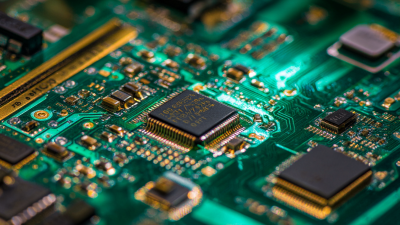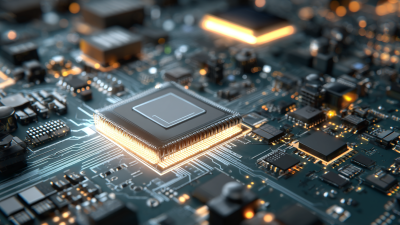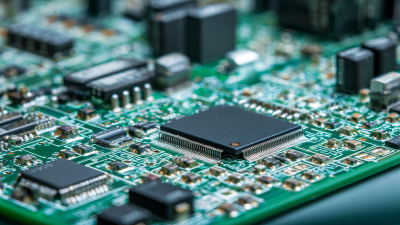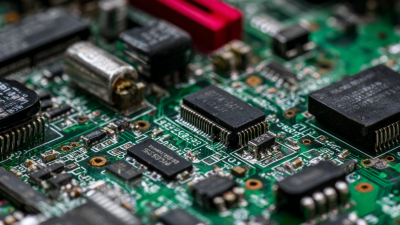Exploring Innovative Alternatives in PCB Design and Assembly for Global Buyers
In the rapidly evolving electronics industry, the demand for efficient and cost-effective PCB design and assembly solutions is more pressing than ever. According to a recent report by IPC, the global printed circuit board market is projected to reach $90 billion by 2025, reflecting a compound annual growth rate (CAGR) of 4.3%. This growth is fueled by innovations in design methodologies and assembly techniques that cater to the needs of global buyers facing challenges such as supply chain disruptions and increasing design complexities. As manufacturers strive to enhance performance while minimizing costs, exploring innovative alternatives in PCB design and assembly becomes critical. This blog delves into the pressing problems faced in the current landscape and highlights potential solutions that not only meet market demands but also push the boundaries of technological advancement in PCB design and assembly.

Innovative Materials Revolutionizing PCB Design and Assembly Processes
The landscape of PCB design and assembly is undergoing a transformative shift, driven by innovative materials that enhance functionality and performance. With the increasing complexity of electronic devices, traditional materials often fall short in meeting the demands of modern applications. Advanced substrates, such as high-frequency laminates and flexible circuits, are now being employed to ensure superior signal integrity and thermal management. These materials not only facilitate miniaturization but also enable the design of more intricate and compact circuit layouts, showcasing their versatility in various industries.
Moreover, environmentally friendly materials are gaining traction in the PCB manufacturing process. Biodegradable substrates and lead-free soldering methods are emerging as sustainable alternatives that promise to reduce the environmental impact of electronic waste. As global buyers place a premium on sustainability, manufacturers are adapting by integrating these innovative solutions into their production lines. This shift not only caters to growing consumer expectations but also positions companies as leaders in a rapidly evolving market, fostering a culture of responsibility and innovation in PCB design and assembly.

Common Challenges Faced by Global Buyers in PCB Procurement
Global buyers in the PCB procurement market often face a myriad of challenges that can impede the efficiency and effectiveness of their supply chains. According to a recent report from IPC, the global electronics contract manufacturing sector is projected to surpass $610 billion by 2025, highlighting the growing demand for printed circuit boards (PCBs). However, buyers frequently encounter issues such as component shortages, long lead times, and fluctuating material costs. A survey from IHS Markit indicates that 56% of electronics manufacturers experienced significant delays due to supply chain disruptions in the past year, emphasizing the need for innovative strategies in procurement.
Additionally, navigating the complexities of geopolitical factors can further complicate the procurement process for global buyers. The ongoing tension in international trade relations impacts tariffs and compliance costs, resulting in an increase of 10-20% in procurement expenses for many companies, as reported by TechNavio. To mitigate these hurdles, buyers are increasingly exploring alternative sourcing strategies, such as local suppliers and digital platforms that enhance transparency and collaboration. Implementing these innovative approaches can lead to more resilient supply chains and ensure timely access to essential PCB components amidst an ever-evolving global market landscape.
Exploring Innovative Alternatives in PCB Design and Assembly for Global Buyers - Common Challenges Faced by Global Buyers in PCB Procurement
| Challenge | Impact on Procurement | Potential Solutions |
|---|---|---|
| Supply Chain Disruptions | Delays in delivery and increased costs | Diversifying suppliers and increasing stock levels |
| Quality Assurance Issues | Risk of product failures and warranty claims | Implementing stricter quality checks and audits |
| Rapid Technological Changes | Need for continual product updates and redesigns | Investing in research and development for new technologies |
| Regulatory Compliance | Legal penalties and product recalls | Staying updated with regulations and improving documentation processes |
| Cost Management | Pressure on profit margins and budget overruns | Optimizing designs and sourcing cost-effective materials |
Strategies for Overcoming Supply Chain Disruptions in PCB Manufacturing
In today's rapidly evolving electronics industry, supply chain disruptions pose significant challenges for PCB manufacturing. Global buyers must adopt innovative strategies to navigate these uncertainties. One effective approach is to diversify sourcing options. By working with multiple suppliers across various geographic regions, companies can mitigate risks associated with reliance on a single source, ensuring that production remains stable even in turbulent times.
Tip: Consider establishing relationships with local suppliers. This can reduce lead times and shipping costs while also providing greater flexibility in response to demand fluctuations.
Additionally, embracing advanced technologies like design automation and inventory management systems can streamline operations. These tools facilitate better planning and forecasting, allowing manufacturers to adjust quickly to changes in supply chain conditions. Implementing a robust disaster recovery plan is equally crucial. By preparing for potential disruptions before they occur, businesses can maintain continuity and minimize the impact on production schedules.
Tip: Regularly audit your supply chain processes and incorporate contingency strategies that can be activated in response to specific disruptions, ensuring a swift recovery when challenges arise.
Emerging Technologies in PCB Assembly: A Game Changer for Design Efficiency
The emergence of innovative technologies in PCB assembly is set to significantly enhance design efficiency, reshaping how global buyers approach this critical component of electronics. Advanced manufacturing processes, driven by breakthroughs in artificial intelligence and digital twin technology, offer unprecedented capabilities for optimizing PCB design. These technologies enable real-time simulations of production processes, leading to reduced time-to-market and improved accuracy in design iterations.
**Tips for Leveraging Emerging Technologies in PCB Design:**
1. **Embrace Digital Twin Technology:** Utilize digital twins to create virtual prototypes of your PCBs. This allows for thorough testing and refinement before physical production, minimizing costly errors.
2. **Integrate Artificial Intelligence:** Implement AI-driven design tools that can analyze patterns and suggest improvements in your PCB layouts, enhancing the overall efficiency and effectiveness of your designs.
3. **Stay Updated on New Materials:** Follow advancements in materials science which can lead to lighter, more durable PCBs. Engaging with innovative materials can result in better performance and sustainability in your products.
The constant evolution of technology in PCB assembly not only enhances efficiency but also opens the door to sustainable practices, aligning with contemporary demands for eco-friendly solutions. By staying proactive in adopting these innovations, companies can gain a competitive edge and fulfill the growing expectations of tech-savvy consumers.
Sustainable Practices in PCB Design: Balancing Innovation and Environmental Responsibility
Sustainable practices in PCB design are increasingly vital as the electronics industry faces growing environmental pressures. According to a recent report by the International Electronics Manufacturing Initiative (iNEMI), the global electronics waste is projected to reach 74 million tons by 2030, urging manufacturers to adopt greener approaches. Innovative PCB design can significantly reduce waste and promote recycling, aligning with the rising demand for eco-friendly electronics. Techniques such as using lead-free solder and selecting materials with lower environmental impact not only help in compliance with regulations like RoHS but also enhance the lifecycle of products.

To embrace sustainability in PCB assembly, companies can implement practices such as multi-layer board designs that minimize raw material usage while maximizing functionality. Additionally, optimizing manufacturing processes through automation can reduce energy consumption by up to 30%, as highlighted by a study from the IPC (Association Connecting Electronics Industries).
Tip: When selecting materials for PCB design, consider those that are not only functional but also recyclable. Opt for suppliers who prioritize sustainable sourcing and waste management practices.
Incorporating renewable energy sources into manufacturing facilities can also be a game changer. A report from the Clean Energy States Alliance indicates that shifting to renewable energy can decrease operating costs by 15-20%, making it an economically viable option while supporting environmental goals.
Tip: Regularly assess your supply chain for sustainability and engage with suppliers who commit to reducing their carbon footprint.
Related Posts
-

Navigating the 2025 PCB Design and Assembly Trends for Global Buyers
-

Challenges with Achieving Best PCB Printing Quality
-

Navigating the Future of Best Printed Circuit Board Assembly in the 2025 Market Landscape
-

How to Optimize Your Flexible Printed Circuit Board Production for Maximum Efficiency and Cost Savings
-

Unlocking the Future of Electronics with the Best Flex PCB Assembly Solutions
-

Best PCB Electronics: A Comprehensive Comparison of Top Choices for Your Projects
MSIRobot